Ten digital years
I got my first digital camera ten years ago, and since then I have acquired several others. Who am I kidding. The true number is not several, it’s ten. Let me explain…
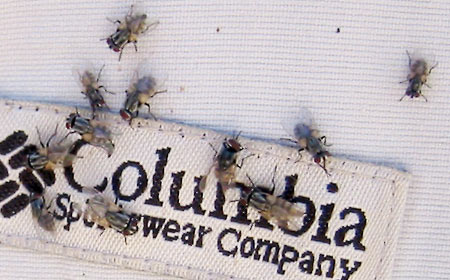
 1 It all started in 2002 when I bought a new Canon Ixus v2. It cost almost $700, captured 2 megapixels, and was a very stylish shirt-pocketful. It was completely automatic, not something I was used to. The viewfinder was squinty, and the LCD on the back was even worse. It introduced me to shutter-lag. But it was handy and I liked being able take a picture and get it into the computer without having to process and scan any film. I took it with me (along with the usual bag of 35mm film cameras and lenses) on a field trip in western Queensland where I took this shot of the flies on Thom Blake’s pants. I no longer have this camera—see below.
1 It all started in 2002 when I bought a new Canon Ixus v2. It cost almost $700, captured 2 megapixels, and was a very stylish shirt-pocketful. It was completely automatic, not something I was used to. The viewfinder was squinty, and the LCD on the back was even worse. It introduced me to shutter-lag. But it was handy and I liked being able take a picture and get it into the computer without having to process and scan any film. I took it with me (along with the usual bag of 35mm film cameras and lenses) on a field trip in western Queensland where I took this shot of the flies on Thom Blake’s pants. I no longer have this camera—see below.
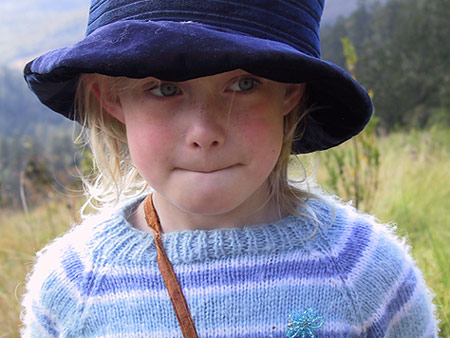
 2 In 2003 I was convinced that a digital camera was a useful tool and I wanted something more capable. I exchanged the Ixus, plus some money, for a used Canon PowerShot G1. The 3 megapixel images were better, but it still had nasty shutter lag and a horrid viewfinder (the pivoting LCD screen was nifty). Despite its frustrations I got good use from it, and I tolerated the occasional blown highlights, as in this snapshot of my daughter Lucy. I still have this camera (for no good reason) but I don’t use it.
2 In 2003 I was convinced that a digital camera was a useful tool and I wanted something more capable. I exchanged the Ixus, plus some money, for a used Canon PowerShot G1. The 3 megapixel images were better, but it still had nasty shutter lag and a horrid viewfinder (the pivoting LCD screen was nifty). Despite its frustrations I got good use from it, and I tolerated the occasional blown highlights, as in this snapshot of my daughter Lucy. I still have this camera (for no good reason) but I don’t use it. 3 In 2004 as I prepared for a sabbatical in New Zealand Canon released the EOS 300D—the first moderately priced digital SLR. I bought one, and left my film cameras at home. By using just the one camera every day for three months I quickly learned what it could do. The results are in my house swapping photoblog. I liked the 300D but I didn’t expect it to challenge my film gear for serious work. Back home, I compared the files from the 300D with scanned film. Even with its cheap kit lens, the 300D was practically as good as my ‘professional’ 35mm camera and lenses (I think the Nikon film scanner was the weak link). I was surprised, and pleased. Soon after that, my 300D was stolen.
3 In 2004 as I prepared for a sabbatical in New Zealand Canon released the EOS 300D—the first moderately priced digital SLR. I bought one, and left my film cameras at home. By using just the one camera every day for three months I quickly learned what it could do. The results are in my house swapping photoblog. I liked the 300D but I didn’t expect it to challenge my film gear for serious work. Back home, I compared the files from the 300D with scanned film. Even with its cheap kit lens, the 300D was practically as good as my ‘professional’ 35mm camera and lenses (I think the Nikon film scanner was the weak link). I was surprised, and pleased. Soon after that, my 300D was stolen.
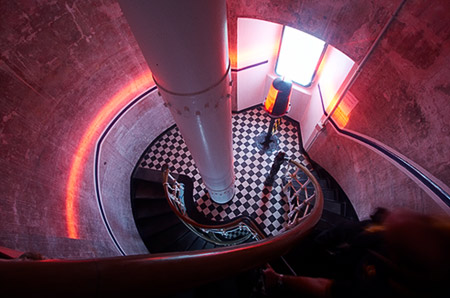
 4 In 2005 the insurance company replaced the stolen camera with the current equivalent, the Canon EOS 350D. I bought the newly released 10-22mm wide angle zoom lens, a 50mm prime lens, and a used 70-200mm f4 L zoom. Now I had a replacement for my film outfit. It came in for some heavy use on my lighthouse survey job. Lighthouses have very confined spaces inside, and the very wide 10-22mm lens was just the thing to catch the atmosphere inside Cape Byron lighthouse. The lighthouse project took a year to do, and my reports on the 58 lighthouses included 2750 images captured with the 350D, processed and placed in InDesign to make PDF documents—it would have been a nightmare to do that with film! I still have the 350D, and use it from time to time.
4 In 2005 the insurance company replaced the stolen camera with the current equivalent, the Canon EOS 350D. I bought the newly released 10-22mm wide angle zoom lens, a 50mm prime lens, and a used 70-200mm f4 L zoom. Now I had a replacement for my film outfit. It came in for some heavy use on my lighthouse survey job. Lighthouses have very confined spaces inside, and the very wide 10-22mm lens was just the thing to catch the atmosphere inside Cape Byron lighthouse. The lighthouse project took a year to do, and my reports on the 58 lighthouses included 2750 images captured with the 350D, processed and placed in InDesign to make PDF documents—it would have been a nightmare to do that with film! I still have the 350D, and use it from time to time.
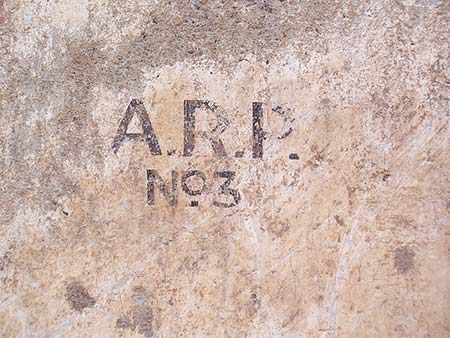
 5 In 2006, at the start of the lighthouse project, I worried about not having a backup camera. I bought a Kodak EasyShare v570, a pocket camera with just one endearing feature—a fairly wide angle lens (equivalent to 23mm on a 35mm frame). I used it to photograph this faded sign on the wall of an ARP control centre installed in a reinforced bunker under the Roma Street Police Headquarters, Brisbane, during World War II. The building was demolished in 1968, and the basement was buried. It survived and was revealed, then destroyed, during construction of the Inner Northern Busway. Thanks to Thom Blake for inviting me to see it, on 15 November 2006. The camera has since been passed around members of the family, and has come to rest on my unused camera pile. The wide angle lens still works, but the second (zoom) lens has given up.
5 In 2006, at the start of the lighthouse project, I worried about not having a backup camera. I bought a Kodak EasyShare v570, a pocket camera with just one endearing feature—a fairly wide angle lens (equivalent to 23mm on a 35mm frame). I used it to photograph this faded sign on the wall of an ARP control centre installed in a reinforced bunker under the Roma Street Police Headquarters, Brisbane, during World War II. The building was demolished in 1968, and the basement was buried. It survived and was revealed, then destroyed, during construction of the Inner Northern Busway. Thanks to Thom Blake for inviting me to see it, on 15 November 2006. The camera has since been passed around members of the family, and has come to rest on my unused camera pile. The wide angle lens still works, but the second (zoom) lens has given up.
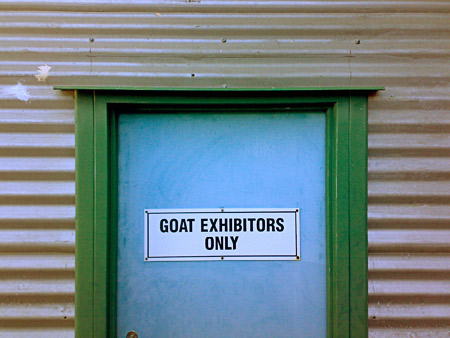
 6 In 2007 I upgraded my mobile phone to something smarter, a second-hand Nokia N73 that had the best phone camera of its day, with a half way decent lens. I had it with me wherever I went, so I used it as a visual notebook, capturing odd bits of visual trivia like this door sign near the goat stables at the Royal National Agricultural Showground in Brisbane. I am not sure whether that door is still there, but I still keep the phone as a spare.
6 In 2007 I upgraded my mobile phone to something smarter, a second-hand Nokia N73 that had the best phone camera of its day, with a half way decent lens. I had it with me wherever I went, so I used it as a visual notebook, capturing odd bits of visual trivia like this door sign near the goat stables at the Royal National Agricultural Showground in Brisbane. I am not sure whether that door is still there, but I still keep the phone as a spare.

 7 In 2007 I bought a like-new second-hand Canon EOS 5D which, at last, gave me a sensor the size of a full frame of 35mm film. I had already bought a like-new second-hand 24mm tilt-shift lens which was a perfect match with the 5D, and I added a second-hand 17-40mm f4 L lens which has become my most useful lens. I used the 5D to photograh this mosaic floor at the Casa d’Oro, Cannaregio, Venice.
7 In 2007 I bought a like-new second-hand Canon EOS 5D which, at last, gave me a sensor the size of a full frame of 35mm film. I had already bought a like-new second-hand 24mm tilt-shift lens which was a perfect match with the 5D, and I added a second-hand 17-40mm f4 L lens which has become my most useful lens. I used the 5D to photograh this mosaic floor at the Casa d’Oro, Cannaregio, Venice.
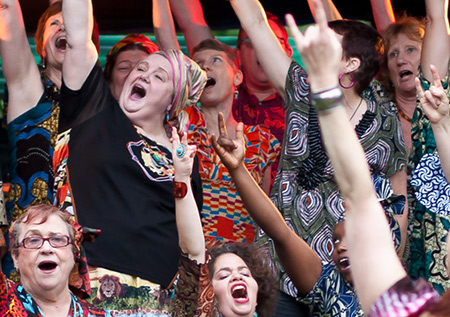
 8 In 2011 the Queensland Police Service sold off a fleet of Canon EOS 30D bodies that had been used by forensic officers. I bought one of these to have as a backup. It shoots faster bursts than the 5D, so I found it useful for catching fast-changing subjects like the Tongues of Fire and Roar choirs performing together here.
8 In 2011 the Queensland Police Service sold off a fleet of Canon EOS 30D bodies that had been used by forensic officers. I bought one of these to have as a backup. It shoots faster bursts than the 5D, so I found it useful for catching fast-changing subjects like the Tongues of Fire and Roar choirs performing together here.
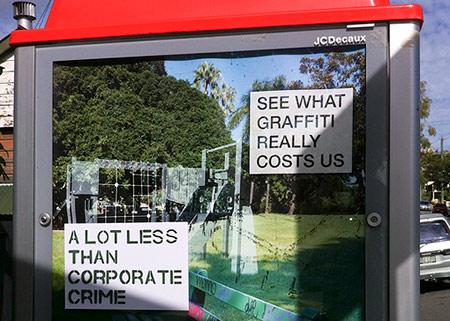
 9 From early 2012 my carry-around camera has been an iPhone 4 which I chose for other reasons that its camera—though it does make better images than the Nokia N73 and the huge range of apps open up some interesting possibilities. For me, these possibilities don’t include automatic manipulation of images to mimic Polaroids, or relentless posting of pictures to social media websites.
9 From early 2012 my carry-around camera has been an iPhone 4 which I chose for other reasons that its camera—though it does make better images than the Nokia N73 and the huge range of apps open up some interesting possibilities. For me, these possibilities don’t include automatic manipulation of images to mimic Polaroids, or relentless posting of pictures to social media websites.
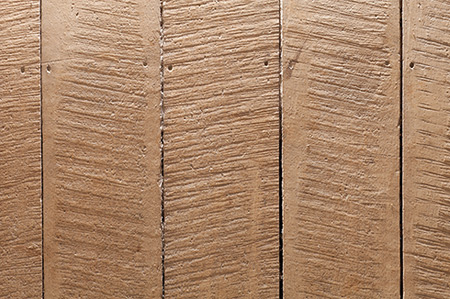
 10 My most recent addition to the fleet is a Canon 5D Mark II whose main attraction is live-view which allows me to accurately manually focus lenses like the Samyang 14mm lens, and the Canon 24mm tilt-shift lens. I often use my cameras on tripods, and aim for the kind of precise and considered working I learned with large-format cameras. This particular camera was not expensive, because it shows the bruises of its former life photographing surfers at Bondi, and because lots of photographers were trading up from this model to the new Mark III.
10 My most recent addition to the fleet is a Canon 5D Mark II whose main attraction is live-view which allows me to accurately manually focus lenses like the Samyang 14mm lens, and the Canon 24mm tilt-shift lens. I often use my cameras on tripods, and aim for the kind of precise and considered working I learned with large-format cameras. This particular camera was not expensive, because it shows the bruises of its former life photographing surfers at Bondi, and because lots of photographers were trading up from this model to the new Mark III.
Of those ten cameras, six were second-hand when I got them. Digital cameras are like computers—each year a flood of new models washes away the value of last-year’s models. I don’t feel the need for the very latest thing, so I am happy to wait and save.



















